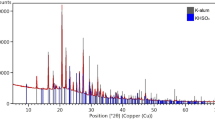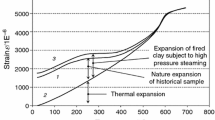Abstract
The TG, DTG and DSC methods were used for investigation of the thermo-oxidative degradation in static air atmosphere and oxygen flow of some sorts of lime tree wood (recent lime tree woods with different preparations, old lime tree woods extracted from some Romanian historical and/or cultural objects). At the progressive heating in the mentioned atmospheres, all the investigated materials exhibit three successive processes, associated with dehydration and two complex thermo-oxidative processes. Each analyzed material has a characteristic thermogram (TG, DTG and/or DSC curve) that can be considered a material “fingerprint”. It was pointed out that the following non-isothermal parameters can be used for distinction between a new and old lime tree wood: mass loss in the first process of thermo-oxidation, ratio between the mass losses in the first and the second processes of thermo-oxidation, the maximum rate of the first process of thermo-oxidation. Consequently, the certification of a patrimonial object manufactured from lime tree wood could be performed by applying the thermal analysis methods.




Similar content being viewed by others
References
Chahine C, Rottier C. European—environmental leather project, Research report, Copenhagen, 1996.
Larsen R. Experiments and observations in the study of environmental impact on historical vegetable tanned leathers. Thermochim Acta. 2000;365:85–99.
Chahine C. Change in hydrothermal stability of leather and parchments with deterioration: a DSC study. Thermochim Acta. 2000;365:101–10.
Cohen NS, Odlyha M, Foster G. Measurement of shrinkage behaviour in leather and parchment by dynamic mechanical analysis. Thermochim Acta. 2000;365:111–7.
Wess TJ, Orgel JP. Changes of collagen structure by drying dehydrothermal treatment and relation to long term deterioration. Thermochim Acta. 2000;365:119–28.
Fessas D, Schiraldi A, Tenni R, Zuccarello LV, Bairate A, Facchini A. Calorimetric, biochemical and morphological investigations to validate a restoration method of fire injured ancient parchment. Thermochim Acta. 2000;348:129–37.
Odlyha M, Cohen NS, Foster GM, Aliev A, Verdonck E, Grady D. Dynamic mechanical analysis (DMA), 13Csolid state NMR and micro-thermomechanical studies of historical parchment. J Therm Anal Calorim. 2003;71:939–51.
Della Gatta G, Badea E, Ceccarelli R, Usacheva T, Masic A, Collucia S. Assessment of damage in old parchment by DSC and SEM. J Therm Anal Calorim. 2005;82:637–49.
Roduit B, Odlyha M. Prediction of thermal stability of fresh and aged parchment. J Therm Anal Calorim. 2006;85:157–64.
Marcolli C, Wiedemann HG. Distinction of original and forged lithographs by means of thermogravimetry and Raman spectroscopy. J Therm Anal Calorim. 2001;64:987–1000.
Odlyha M, Cohen NS, Campara R, Foster GM. Environmental research for art conservation and assessment of indoor conditions surrounding cultural objects. J Therm Anal Calorim. 1999;56:1219–32.
Prati S, Chiavari G, Cam D. DSC application in the conservation field. J Therm Anal Calorim. 2001;76:315–27.
Knappe S, Mohler H, Opfermann J, Walter H. Thermal analysis for paints. Germany: Netzsch-Geratebau GmbH; 2001.
Wiedemann HG, Arpagaus E, Muller D, Marcolli C, Weigel S, Reller A. Pigments of the bust of Nefertiti compared with those of Karnak Talatats. Thermochim Acta. 2002;382:239–47.
Genestar C, Cifre J. Thermal analysis for the characterization of grounds used in works of art: preliminary results. Thermochim Acta. 2002;385:117–26.
Foster GM, Ritchie S, Lowe C. Controlled temperature and relative humidity dynamic mechanical analysis of paint films. J Therm Anal Calorim. 2003;73:119–26.
White RE, Thomas PS, Phillips MR, Wuhre R. A DSC study of the effect of lead pigments on the during of cold pressed linseed oil. J Therm Anal Calorim. 2005;80:237–9.
Heide K, Hartmann E, Gent K, Wiedemann HG. MS-TGA of ancient glasses: an attempt to determine the manufacturing conditions (I). Thermochim Acta. 2000;365:147–56.
Campanella L, Favero G, Flamini P, Tomassetti M. Prehistoric terracottas from the Libyan Tadrart Acasus. J Therm Anal Calorim. 2003;73:127–42.
Drebuschchak VA, Mylnikova LN, Drebushchak TS, Boldyrev VV. The investigation of ancient pottery. Application of thermal analysis. J Therm Anal Calorim. 2005;82:617–26.
Shoval S, Beck P. Thermo-FTIR spectroscopy analysis as a method of characterizing ancient ceramic technology. J Therm Anal Calorim. 2005;80:609–16.
Wang Q, Odlyha M, Cohen NS. Thermal analysis of selected soil samples from the tombs at the Tianma-Qucun site, Shanxi, China. Thermochim Acta. 2000;365:189–95.
Anastasiou H, Hasapis Th, Zorba T, Pavlidou K, Chrissafis E, Paraskevopoulos KM. TG-DTA and FTIR analyses of plasters from Byzantine monuments in Balkan region. J Therm Anal Calorim. 2006;84:27–32.
Silva DA, Wenk HR, Monteiro PJM. Comparative investigation of mortars from Roman Colosseum and cistern. Thermochim Acta. 2005;438:35–40.
Odlyha M, Wang Q, Foster GM, de Groot J, Horton M, Bozek L. Thermal analysis of model and historic tapestries. J Therm Anal Calorim. 2005;82:627–36.
Friolo KH, Ray AS, Stuart BH, Thomas PS. Thermal analysis of heritage stones. J Therm Anal Calorim. 2005;80:559–63.
Budrugeac P, Miu L, Bocu V, Wortmann FL, Popescu C. The use of thermal analysis methods in investigation of the thermal degradation of collagen-based materials that are supports of cultural and historic objects. J Therm Anal Calorim. 2003;72:1057–64.
Budrugeac P, Miu L, Popescu C, Wortmann FJ. Identification of collagen-based materials that are supports of cultural and historical objects. J Therm Anal Calorim. 2004;79:975–85.
Popescu C, Budrugeac P, Miu L, Idiţoiu C, Wortmann FJ. Thermal analysis of patrimonial leather objects. 30-th Aachen textile conference, Aachen, Germany, 2003.
Budrugeac P, Miu L, Souckova M. Use of thermal analyses methods and scanning electron microscopy to asses the damage in the patrimonial books from Romanian libraries. J Therm Anal Calorim. 2007;88:693–8.
Badea E, Miu L, Budrugeac P, Giurginca M, Mašić A, Badea N, et al. Study of deterioration of historical parchments by various thermal analysis techniques completed by SEM, FTIR, UV-VIS-NIR and unilateral investigations. J Therm Anal Calorim. 2008;91:17–27.
Popescu C, Budrugeac P, Wortmann FJ, Miu L, Demco DE, Baias M. Assessment of collagen-based materials which are supports of cultural and historical objects. Polym Degrad Stab. 2008;93:976–82.
Budrugeac P, Miu L. The suitability of DSC method for damage assessment and certification of historical leathers and parchments. J Cult Herit. 2008;9:146–53.
Campanella L, Tomassetti M, Tomellini R. Thermoanalysis of ancient, fresh and waterlogged woods. J Therm Anal Calorim. 1991;37:1923–32.
Tomassetti M, Campanella L, Tomellini R, Meuci C. Thermogravimetric analysis of fresh and archeological waterlogged woods. Thermochim Acta. 1987;117:297–315.
Tomassetti M, Campanella L, Tomellini R. Thermogravimetric analysis of ancient and fresh woods. Thermochim Acta. 1990;170:51–65.
Wiedemann HG. Thermoanalytische untersuchung von baumaterialien ägyptischer mumiensärge. J Therm Anal. 1998;52:93–107.
Wiedemann HG, Wood LI. Wood. In: Kemp RB, editor. Handbook of thermal analysis and calorimetry. Vol 4, Chap 14. Amsterdam: Elsevier; 1999.
Sandu ICA, Brebu M, Luca C, Sandu I, Vasile C. Thermogravimetric study on the ageing of lime wood supports of old paintings. Polym Degrad Stab. 2003;80:83–91.
Wiedemann HG. Thermal analysis of the wood components in relation to growth period of tree. Thermochim Acta. 1993;229:215–28.
Gao M, Sun C, Zhu K. Thermal degradation of wood treated with guanidine compounds in air. Flammability study. J Therm Anal Calorim. 2004;75:221–32.
Franceschi E, Cascone I, Nole D. Thermal, XRD and spectrophotometric study on artificially degraded woods. J Therm Anal Calorim. 2008;91:119–25.
Slusarski L. Thermal stability of elastomers. J Therm Anal. 1984;29:905–12.
Vasile C. Degradation and decomposition. In: Vasile C, editor. Handbook of polyolefins. 2nd ed, Chap 17. New York: Dekker; 2000.
Reh U, Krapelin G, Lamprecht I. Differential scanning calorimetry as a complementary tool in wood biodegradation studies. Thermochim Acta. 1987;119:143–50.
Reh U, Krapelin G. Characterization of wood for musical instruments by DSC analysis. Thermochim Acta. 1993;151:91–7.
Dr Sho-IchiTsujiyama, Miyamori A. Assignment of DSC thermograms of wood and its components. Thermochim Acta. 2000;351:177–81.
Acknowledgements
This work was performed within project PN II nr. 91_003/2/2007, financially supported by Romanian Ministry of Education and Research.
Author information
Authors and Affiliations
Corresponding author
Rights and permissions
About this article
Cite this article
Budrugeac, P., Emandi, A. The use of thermal analysis methods for conservation state determination of historical and/or cultural objects manufactured from lime tree wood. J Therm Anal Calorim 101, 881–886 (2010). https://doi.org/10.1007/s10973-009-0671-6
Received:
Accepted:
Published:
Issue Date:
DOI: https://doi.org/10.1007/s10973-009-0671-6




